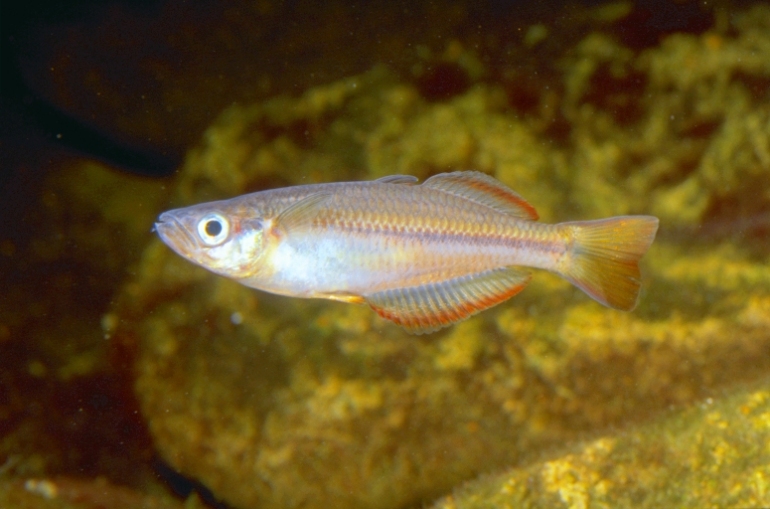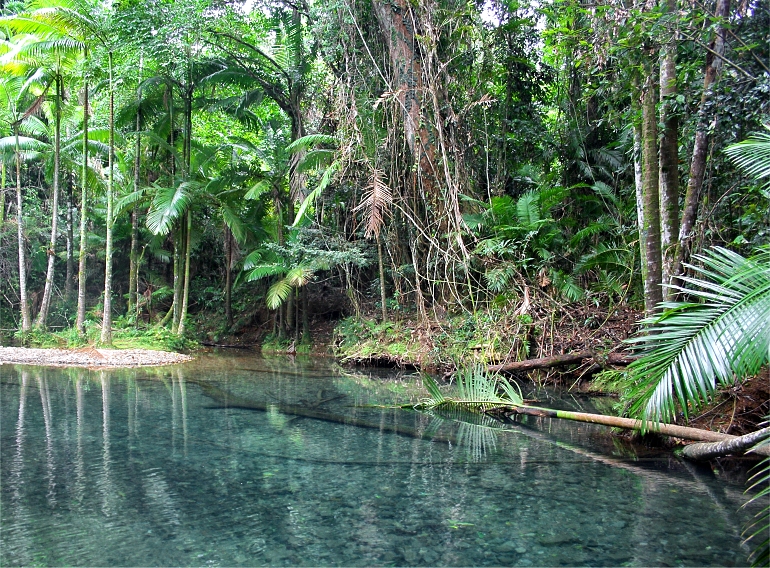|
 |
Cairnsichthys rhombosomoides - photo© Gunther Schmida |
Cairnsichthys were originally collected by Henry Raven in October, 1921 from Babinda Creek, a tributary of the Russell River in north Queensland. They were scientifically described in the American Museum Novitates Nr. 296, in 1928 by John T. Nichols and Henry C. Raven and placed in the genus Rhadinocentrus. Gerald Allen's revision of the family Melanotaeniidae in 1980 placed them in the genus Cairnsichthys in recognition of its distinctiveness. The genus is endemic to a relatively small area of specialised habitat within the Wet Tropics bioregion of north-eastern Queensland, Australia. It was previously considered as being monotypic, and included only a single species, Cairnsichthys rhombosomoides. The discovery of another population in the Daintree rainforest region, approximately 120 km north of their known range, prompted a detailed investigation of its taxonomic status which resulted in a new species, Cairnsichthys bitaeniatus, being described. The new species differs morphologically primarily by having a more slender and narrow shape, featuring a flatter, straighter predorsal profile and shorter second dorsal fin base; possession of slightly smaller scales, reflected in higher counts of lateral scales and predorsal scales; typically more vertebrae; and colour differences including a more robust, short black stripe across the upper operculum, a pronounced yellow patch on the anteroventral body and usually a more conspicuous second dark stripe on the lower body, with adult males generally having yellowish compared to reddish fins.
Cairnsichthys rhombosomoides (Nichols & Raven, 1928)
Cairns Rainbowfish
Species Summary
The body colouration of C. rhombosomoides is generally yellow to brownish on the upper half of body with fine, darker brown scale outline, frequently with yellowish hue, especially those on uppermost row of back and just above midlateral dark stripe; relatively narrow blackish midlateral stripe from upper pectoral fin base to base of caudal fin, narrower on anterior half of body, gradually expanding to about one scale width on caudal peduncle, faint whitish to yellow hue below stripe mainly restricted to the anterior half of body; lower half of body blueish to white, sometimes with a diffuse blue to greyish stripe parallel to main stripe extending posteriorly to base of posterior anal fin, but stripe generally absent or represented by patchy faint marks arranged in a line; head brownish grey, lips dark greyish anteriorly; small rectangular blueish to black mark on the upper operculum, sometimes quite faint, its vertical width usually less than half the pupil diameter, although slightly wider in fish from Harvey Creek, silvery to yellow area below mark; iris silver to bluish on upper half and yellowish to silver below; fins mainly translucent to slightly orange brown to reddish, with faint blue to blackish spot on base of pectoral fin. Colour intensifies in spawning males with more prominent submarginal dorsal and marginal stripes on the second dorsal and anal fin. They may reach a maximum body size of 10 cm, but are usually around 7 cm. Males can be distinguished from females by their elongated dorsal and anal fins and brighter colours - females have shorter and more rounded fins. Males are also larger and deeper bodied than females.
Distribution & Habitat
Cairnsichthys rhombosomoides is restricted to a number of coastal streams in northern Queensland. They have been collected from the Yarrabah Peninsula east of Cairns, and the Hull, Johnstone, Moresby, Mulgrave, Russell and Tully river systems, plus Liverpool and Maria Creeks. They also occur in some small isolated coastal streams around the Innisfail region.
Cairnsichthys rhombosomoides are generally found in small schools swimming above or among aquatic plants, woody debris and leaf litter. They can be found in both lowland and headwater tributary streams in water depth ranging from a few centimetres to about three metres. They are however, more commonly found in water between 30-50 cm deep. Upland streams generally have higher water flow over a substrate composed mainly of large rocks and bedrock with sand and fine gravel with good riparian cover (remnant rainforest) and minimal aquatic plants. Small lowland streams usually have mud, sand and fine gravel substrates with abundant leaf litter. They are often found in company with Melanotaenia splendida, Melanotaenia maccullochi and Melanotaenia utcheensis.
Very little is known about the natural life history and ecology of Cairnsichthys rhombosomoides. Water conditions recorded in their natural habitat are: temperature 15-29°C; pH 4.5-8.5 (lowland 4.5-6.8, upland 7.5-8.5); conductivity 0-91 mS/cm. Their diet is not well documented but appears to be dominated by small terrestrial insects and spiders.
.jpg) |
Cairnsichthys rhombosomoides habitat (Babinda Creek) |
Like all members of the rainbowfish family, Cairnsichthys rhombosomoides are egg-scatterers and generally spawn amongst aquatic plants and leaf litter. In captivity, I have on a regular basis observed this species spawning in the gravel substrate. Spawning has been observed from April-December with a peak during August-October. Sexual maturity occurs at about 3-4 cm for both sexes. Fish commence spawning in their first year and mature females produce between 40 and 200 eggs. The number of eggs shed by a single female is directly related to the size of the female. Eggs adhere to water plants or artificial spawning medium and hatch after 5-9 days depending on temperature. Egg size is around 1.139 ± 0.021 mm with larvae hatching at about 3.46-5.46 mm. Larval development is complete at around 14-15 mm body length. I found this species seems to ignore free-swimming larvae in their aquarium. Although the larvae always stay close to some form of cover and generally avoid open areas of the aquarium.
Cairnsichthys bitaeniatus Allen, Hammer & Raadik, 2018
Daintree Rainbowfish
Species Summary
The body colouration of Cairnsichthys bitaeniatus is generally brownish on the upper half of body with fine, darker brown scale outline, frequently with yellowish hue, especially those on uppermost row of back and just above midlateral dark stripe; relatively narrow blackish midlateral stripe from upper pectoral fin base to base of caudal fin, narrower on anterior half of body, gradually expanding to about one scale width on caudal peduncle, yellow hue below the mid-lateral stripe and just behind the pectoral fin base; lower half of body blueish to white with large zone of pale yellow immediately behind pectoral fin base, also a more diffuse blackish stripe usually present below yellow zone, extending posteriorly to base of posterior anal fin; head brownish grey with yellowish suffusion, lips dark greyish anteriorly; prominent rectangular black mark on upper operculum, its vertical width nearly equal to pupil diameter, with yellow area immediately below and sometimes immediately above; iris bluish on upper half and yellow to blueish below; fins mainly translucent to slightly yellowish, with prominent blackish spot on base of pectoral fin and also invading axil of fin. Colour intensifies in mature males.
Although similar in general appearance, C. bitaeniatus differs from C. rhombosomoides in several colour pattern features, including a more robust black stripe across the upper operculum, a more intense black spot on the pectoral fin base, a pronounced yellow patch on the anteroventral body, and usually a more conspicuous second dark stripe on the lower body. The last-mentioned feature is generally absent, or relatively diffuse, in C. rhombosomoides. Furthermore, the submarginal dorsal and marginal stripes on the second dorsal and anal fin of spawning males are generally yellow in C. bitaeniatus in comparison to orange-reddish in C. rhombosomoides.
Cairnsichthys bitaeniatus has slightly smaller scales than C. rhombosomoides, which is reflected in a higher lateral scale count (38-40, mean 38.8 versus 36-38, mean 37.2), particularly discernible in the anterior half of the fish as a count between the adpressed posterior tip of the pectoral fin and a vertical line from the dorsal fin origin (3-5, mean 4.1 versus 2-4, mean 2.9), and in distinctive predorsal scale counts, with Cairnsichthys bitaeniatus having 18 or more scales (usually 19-21) versus less than 19 scales in C. rhombosomoides (usually 17-18). There is also a modal difference in the total number of vertebrae with that of C. bitaeniatus ranging from 37-40 (mean 38.8) compared to 36-39 (mean 37.2) for C. rhombosomoides.
 |
Cairnsichthys bitaeniatus habitat (Cooper Creek) |
Distribution & Habitat
Cairnsichthys bitaeniatus are currently known only from the Cooper Creek and Hutchinson Creek systems of Cape Tribulation in northern Queensland. The Cape Tribulation region includes several short coastal streams that are located between the Bloomfield River and the Daintree River. No information is currently known about the natural life history or ecology of C. bitaeniatus. It is presumed that C. bitaeniatus has similar reproduction and feeding habits as C. rhombosomoides.
Literature
Burrows D.W. (1998) FNQ 2010 Regional Environment Strategy - Key Waterways Report. ACTFR, Townsville, Qld.
Hammer M.P., G.R. Allen, K.C. Martin, M. Adams, B.C. Ebner, T.A. Raadik and P.J. Unmack (2018) Revision of the Australian Wet Tropics endemic rainbowfish genus Cairnsichthys (Atheriniformes: Melanotaeniidae), with description of a new species. Zootaxa 4413 (2): 271-294.
Martin K.C. and S. Barclay (2013) New Distribution Records for the Cairns Rainbowfish Cairnsichthys rhombosomoides (Melanotaeniidae): implications for conservation of a restricted northern population. aqua, International Journal of Ichthyology, 19(3): 155-164.
Nichols J.T. and H.C. Raven (1928) A New Melanotaeniin fish from Queensland. American Museum Novitates Nr. 296, American Museum of Natural History.
Pusey B.J., M.J. Kennard and A.H. Arthington (2004) Freshwater Fishes of North-Eastern Australia. CSIRO Publishing, Victoria.
Thuesen P.A., B.J. Pusey, D.R. Peck, R. Pearson and B.C. Congdon (2008) Genetic differentiation over small spatial scales in the absence of physical barriers in an Australian rainforest stream fish. Journal of Fish Biology 72(5): 1174-1187.
Updated April, 2018



|
|

